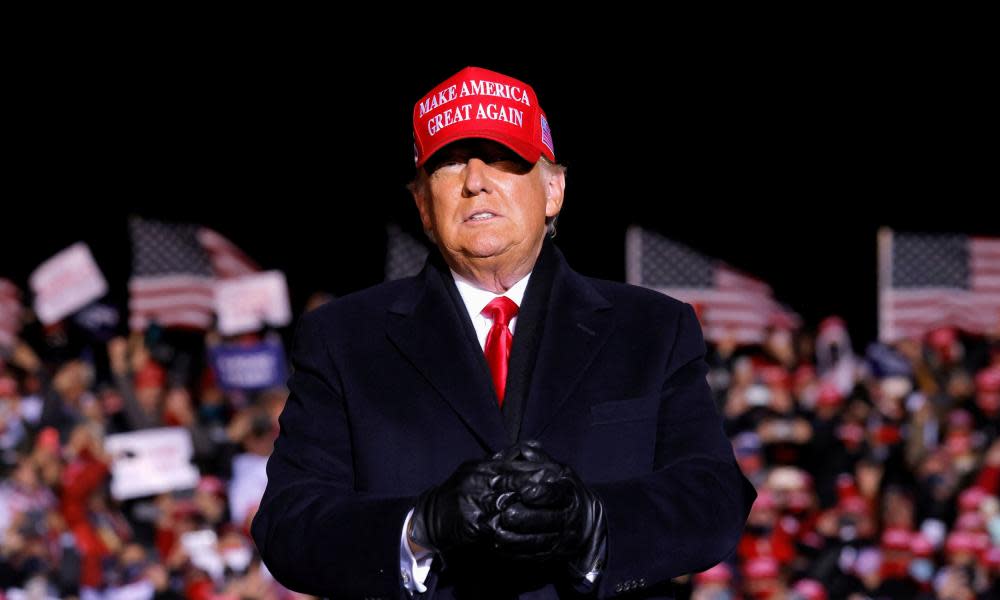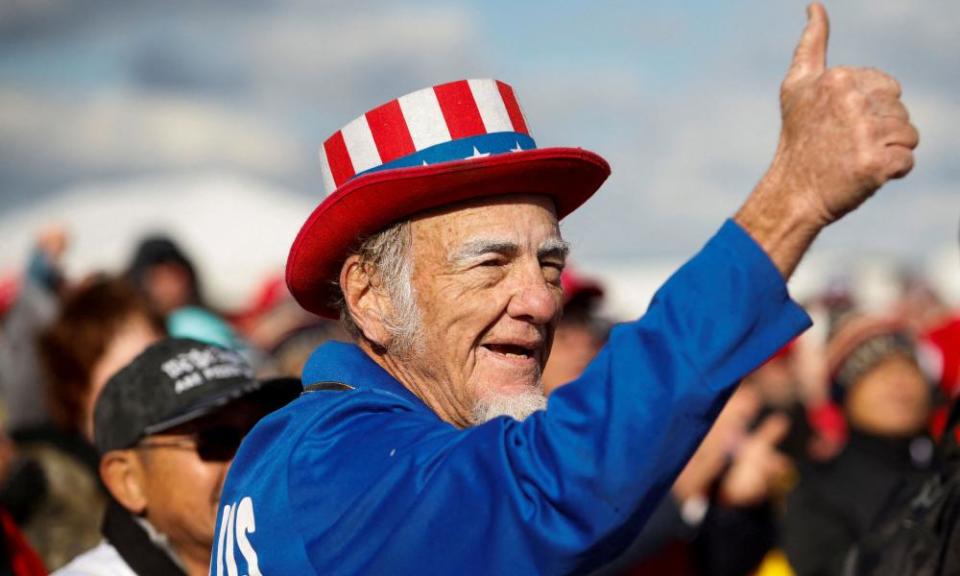Questions abound as Trump raises – and hoards – huge sums of 2024 cash

- Oops!Something went wrong.Please try again later.
Donald Trump’s ferocious money-raising machine, powered in equal measure by grassroots giving and large individual and corporate donations, has never really stopped turning – and it is currently raising huge sums of cash.
Related: Bannon’s escape plan: how the Trump strategist is trying to dodge prison
As of this month, Trump has $108,046,100 saved in his Save America political fund, more than the Republican and Democratic national committees combined, and 12 times as much as the fund – Pac for the Future – for the Democratic House speaker, Nancy Pelosi.
And all of that has been raised while Trump’s own ambitions remain unclear. Though his grip on the Republican party remains tight – and he has waged an endorsement war against his opponents – the big question over whether Trump will run again for the White House remains unanswered.
Without any declared candidacy, his war chest’s purpose and thus also that of its master, is unclear – and deliberately so.
Trump cannot easily spend the money on himself should he decide to run in 2024. Save America is registered as a leadership pac, or political action committee, not a campaign tool for himself. Yet Trump is not yet spending much, according to its “leadership” purpose of supporting Republican candidates going into this year’s hotly contested midterm elections.
Despite Trump’s more than 120 Republican endorsements, and even as Democrats pour money into the effort to retain control of Congress, the massive accumulation of cash under his control raises the question: what is it for?
Trump has not stopped raising money since he left office, either through thousands of small donations raised at Trump rallies or online, or via the big donor money-machine that Democrats cannot match – being schmoozed by Trump himself on the golf course and in the dining room at Mar-a-Lago.
Since Trump founded Save America in November 2020, the group has raised $124m – the largest war chest ever built by an ex-president – but spent only about $14m, or around 11%.
In contrast, the main fund for supporting Senate Republican candidates has spent about 80% of the $135m it raised since the start of 2021, while its main fund for congressional candidates has spent half of the $162m it has raised in the same period.

The question of Trump’s pac money is beginning to vex strategists on both sides of the political divide. It could be a fund designed to ensure the loyalty of Republican allies forming a new power base within the party, or he may have other designs – namely securing his own path forwards by securing the political future of loyalists.
“It’s consistent with Trump’s political priorities – Trump first above everything else – and makes him well positioned for a presidential run in 2024,” said the Democratic consultant Carly Cooperman.
“It’s possible he decides to make a big splash in competitive races as we get closer to the midterm elections, but above all, Trump’s immense popularity and ability to raise large sums of money makes him even more powerful in the Republican party,” Cooperman added.
According to FEC financial disclosures, Save America spent more than $3m on events through February, $2m on consulting services, including to law firms representing witnesses sought by committee investigating the January 6 Capitol riot, including the Trump aide Dan Scavino and Trump spokesperson Taylor Budowich.
It also spent $300,000 on ads, $200,000 in contributions to Republican congressional candidates, and at least $170,000 at hotels owned by Trump for lodging, meals and the renting of hotel facilities.
Budowich, communications director for both Save America and Trump, told Reuters that the former president was supporting candidates through direct contributions, rallies and joint fundraisers – in other words, efforts that bind candidates to the former president.
“Save America will not be telegraphing specific tactics or expenditures through the press,” Budowich told the news agency. “Every dollar raised will go to ensuring President Trump’s “America first” agenda is advanced through his endorsed candidates and causes.”
“There is a lot of leeway to how the funds are spent,” says Michael Beckel of Issue One, a non-partisan group that advocates for campaign finance reform. “While he remains an unofficial candidate he can build his brand, draw further attention to himself by hosting large rallies, ostensibly to support other candidates in other states, but every rally has the upside of helping to boost his visibility and brand.”
Trump is certainly on the move, holding rallies across the US with the usual aim of endorsing local supportive politicians. In some ways, it’s a substitute for social media blackout, in another it’s Trump connecting with his base in the way that has served him in the past.
Earlier this month, he held a rally in South Carolina in support of Russell Fry, a state representative he endorsed to challenge the incumbent Republican congressman Tom Rice.
Fry spoke briefly, before handing the podium back to Trump who continued for 20 minutes. “In 2024 we are going to take back that beautiful White House. I wonder who will do that. I wonder, I wonder,” Trump teased.
But the consequences from straying from Trump’s agenda are also apparent. Last week, the former president withdrew his endorsement of Mo Brooks for “going woke” after the Alabama Senate candidate expressed doubt that the 2020 presidential election was a fraud.
“Mo Brooks of Alabama made a horrible mistake recently when he went ‘woke’ and stated, referring to the 2020 presidential election scam, ‘Put that behind you, put that behind you,’” Trump said, as he withdrew his endorsement.
But Trump’s enduring influence efforts are not limited to rallies or building his power base. Last Tuesday, Axios reported that Donald Trump Jr is planning to launch a mobile news app after the bumpy launch of Truth Social, a Trump-aligned social media network “that encourages an open, free, and honest global conversation without discriminating against political ideology”.
The aggregator site comes with high ambitions to compete with Apple and Google’s news aggregators, and to supplant the Drudge Report that has lost traffic and influence since founder Matt Drudge undercut the White House message on Covid deaths at the peak of the pandemic.
A spokesman said that the news site, MxM (short for “Minute by Minute”), will carry the tag “mainstream news without the mainstream bias” and would carry news “from a variety of publishers across the ideological spectrum”.
With about 12 employees, an ideologically copacetic news site could be a useful tool. But it is still Trump’s money that is the focus of interest when it comes to his future ambitions.
Under election finance laws, should Trump decide to run in 2024, he would have to start a new campaign fund. His previous pac committee, Donald J Trump for President (since renamed The Make America Great Again Pac) still has more than $6m in it, after raising $13m in 2021.
“The life of a political action committee after a candidate leaves office can morph to supporting other candidates,” explained Beckel. “The bulk of the money Trump has been raising is for Save America, but he also has a conduit vehicle so a donor can write one check and it’s split between buckets according to political contribution limits.”
But how Trump will spend the money remains an open question, Beckel says. “He could shape the 2022 midterms or other future elections significantly if he decides to unleash it. One can predict from how other former president or politicians have spent their money, but Donald Trump is not a conventional politician.”

